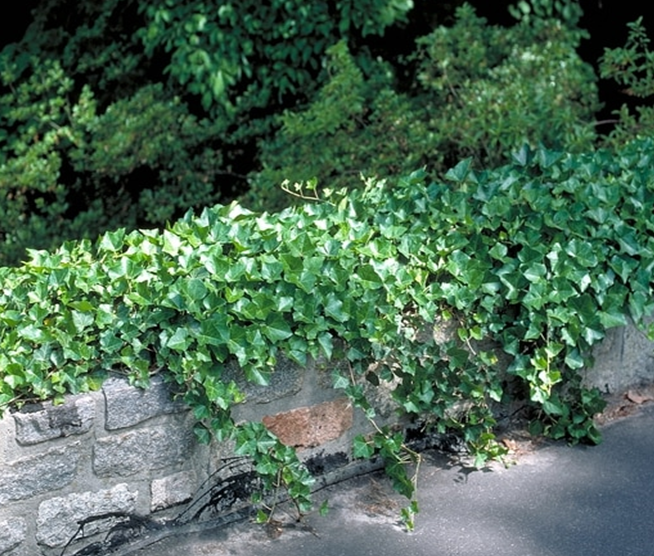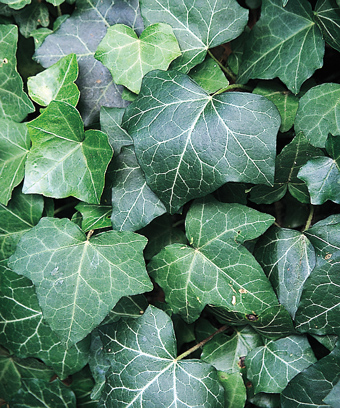by Ken Lain, the mountain gardener
The only evergreen vine that stays green in shady gardens. Large lustrous foliage stays waxed green through winter, forming a lush blanketing groundcover under large shrubs and trees. Quickly climbs walls, pillars, arbors, and fences without support. One of the best vines uses is dangling from the edges of hanging pots and baskets or cascading off the edges of tall urns planted with upright fillers.

A European native, English ivy was brought to the New World by colonial settlers and soon naturalized into the wild. Ivy League college’s nickname came from the Ivy-covered walls of this plant. The plant is versatile and famous as an indoor houseplant or grown outdoor in hanging baskets.
Frequently used as a dense groundcover in places where turfgrass and other groundcovers do not readily grow. It is also used as an ornamental climbing cover for fences, stone walls, and brick facades. English Ivy can reach 100 feet in length as a groundcover or upward as a climbing vine. As a groundcover, the plants grow about 6 to 8 inches tall.
Botanical Name Hedera helix
Common Name English ivy
Plant Type Perennial woody evergreen vine
Mature Size 6 – 8 inches high; up to 15 feet long as a vine
Sun Exposure Filtered sun or full shade
Soil Type Rich soil with plenty of organic material
Soil pH 6.0 to 7.8
Hardiness Zones 4 to 8 USDA
Native Area Northern Europe and western Asia
How to Plant and Grow English Ivy
Properly grown, Ivy makes a beautiful trailing plant or climbing, and fantastic for topiaries.
The secret to growing healthy Ivy is to provide cool nights with bright days. Clinging aerial roots enable the plant to grow up supports or be allowed to trail from hanging baskets.
Light
In both winter and summer, Ivy requires bright light but avoid direct sunlight in summer. In winter, plants can accept a bit of direct sunlight, such as south-facing windows.

Soil
Fertile, moist, well-drained soil is ideal for English ivy. In dryer mountain soils, the ground should be heavily mulched to retain moisture and keep it cool. Indoors, English ivy grows best in Watters Organic Potting Soil.
Water newly planted Ivy regularly with a garden hose for at least one month (2 months in Summer). Automatic irrigation systems may not be sufficient initially. Water frequency will vary according to the season, exposure, and plant size.
April – Oct this Ivy should be irrigated 2 x weekly.
Nov – Mar this Ivy should be irrigated 2 x monthly.
Indoor potted Ivy prefers moist, humid conditions, but not soaking. Don’t let the soil dry out and keep it evenly moist.
Temperature and Humidity
Outdoors, English ivy does best in moderate conditions, protected from both harsh winter winds and excessive summer heat. Very humid conditions can encourage root rot and bacterial leaf spot.
Ivy grown indoors prefer cooler nights, often below 60 degrees Fahrenheit. Many species can overwinter outside in pots and will grow back from their stems. During hot summer days, mist frequently.
Feed 4x Times per Year with either 7-4-4 All Purpose Plant Food, Soil Sulfur, or Humic. Here’s the recommendation by season:
Spring = 7-4-4 All Purpose Food + Soil Sulfur
Summer = 7-4-4 All Purpose Food + Humic
September = 7-4-4 All Purpose Food
December = 7-4-4 All Purpose Food
Repotting
Repot small ivy plants into fresh Watters Potting Soil every year, or every other year for larger plants. Old, tired plants can be refreshed and replanted into their same containers with new Potting soil.
Varieties of English Ivy
The most popular Ivy sold at Watters Garden Center is true Ivy, from the genus Hedera. We actually sell 15 species of Hedera, but Hedera helix is the star as far as cultivated plants are concerned. It has been extensively hybridized into several exciting leaf patterns and shapes. Growth requirements for all Hedera ivies are similar.
Pruning
It’s hard to make a mistake when pruning Ivy. It grows with such vigor you simply feed with Watters 7-4-4 Plant Food, and the vine will grow its way out of any error. To keep Ivy compact and bushy, pinch off the growing tips. Vigorously cut back plants every three or four years to rejuvenate growth. When planted as an outdoor ground cover, cut away the edges with a spade to trim it.
Common Pests/ Diseases
Aphids and spider mites are the most common pests. Spray with Watters Multi-Purpose Insect Control for the best treatment.

